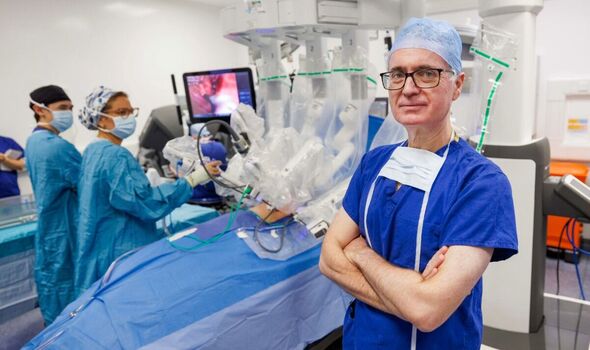Science
Robotic Surgery Revolution Set to Transform NHS Patient Care

Health authorities in the United Kingdom are celebrating a significant advancement in surgical technology that promises to reduce recovery times and help alleviate NHS waiting lists. The introduction of robotic-assisted surgery is expected to increase the number of procedures performed annually from 70,000 to 500,000 over the next ten years.
Professor Meghana Pandit, the NHS national medical director, has highlighted the growing prevalence of this technology, describing it as “quickly becoming the norm.” She emphasized the potential benefits, stating that as robotic surgery continues to expand within the NHS, it will enhance patient recovery, improve surgical accuracy, and diminish complications associated with invasive procedures.
The NHS aims for 90% of keyhole surgeries—those conducted through small incisions—to be performed using robotic systems within a decade, a significant rise from the current 20%. Experienced surgeons utilizing robotic assistance can perform these operations more swiftly, allowing for quicker patient recoveries and earlier hospital discharges.
At Guy’s Hospital in London, known for its extensive thoracic surgery department, a recent demonstration showcased the capabilities of robotic surgery. During a procedure to remove a small tumor from a patient’s left lung, lead surgeon Tom Routledge noted that the patient would be awake within half an hour and able to enjoy a cup of tea shortly after surgery. The entire operation lasted approximately 90 minutes, with Mr. Routledge and his apprentice operating from consoles located two meters away from the patient.
Mr. Routledge, a pioneer in robotic surgery within the NHS, reflected on the evolution of this technology. “When I started doing this 10 years ago, it was relatively novel,” he said. “Now, it has very much moved into the mainstream.” The robotic systems utilize articulated arms that are inserted through small incisions, enabling precise movements. One arm holds a camera, while others manipulate surgical instruments.
The learning process for new surgeons involves mastering both manual techniques and robotic controls. Trainees practice on simulators and animal models before participating in actual operations. Dr. Christoph Zacherl, a trainee from Austria, highlighted the advantages of robotic assistance, stating that it allows for less invasive procedures with reduced bleeding.
Data from Mr. Routledge’s operations indicate that approximately 7% of patients experience complications after robotic-assisted surgeries, compared to 20% with traditional open surgeries and 15% with video-assisted keyhole surgeries. “We’re very aware that unlike a lot of treatments, surgery upfront hurts and is destructive to tissue,” he explained, noting that robotic techniques can potentially reduce pain compared to other surgical methods.
Patients undergoing robotic-assisted procedures can expect shorter hospital stays. The lung cancer patient in the demonstration will likely be discharged in a couple of nights rather than the typical three or four nights required for manual surgeries. This expedited recovery not only benefits patients but also alleviates pressure on hospital resources.
The robotic technology also offers ergonomic advantages for surgeons. Mr. Routledge pointed out that traditional manual surgeries can be physically taxing, often leading to musculoskeletal injuries that can shorten a surgeon’s career. Working comfortably at a console allows for better decision-making during complex operations.
As the procedure progressed, the team successfully removed a lymph node for laboratory analysis while minimizing risks associated with blood vessel tears. The operation proceeded smoothly, and the team was prepared to start another surgery shortly afterward.
The UK’s largest robotic surgery center, Guy’s and St Thomas’s NHS Foundation Trust, conducts around 800 lung operations annually, utilizing robotic assistance across multiple specialties, including urology and transplant surgery. Since the installation of the first da Vinci system in 2004, over 12,000 patients have benefited from robotic procedures at this facility.
While some envision a future where artificial intelligence handles entire surgeries, Mr. Routledge believes such advancements are unlikely in the near term due to safety concerns and patients’ preferences for human involvement in their healthcare. The National Institute for Health and Care Excellence recently approved 11 robotic systems for various surgical procedures, further integrating this technology into the NHS framework.
The cost of a da Vinci Xi system is approximately £1.5 million, a price comparable to mid-range hospital equipment. Although robotic surgeries are more expensive than manual options, they result in savings through reduced hospital stays and lower complication rates.
Ashley Dalton, Minister for Public Health and Prevention, praised the implementation of robotic surgery, stating it liberates clinical teams to allocate resources more effectively and further reduce waiting lists. Dr. Jesme Fox, medical director for the Roy Castle Lung Cancer Foundation, welcomed the expansion of robotic-assisted surgery, emphasizing the benefits for lung cancer patients who require less invasive treatment options.
As the NHS continues to embrace this technological revolution, it is poised to redefine surgical care, enhancing patient outcomes and transforming the landscape of healthcare delivery in the UK.
-

 Health3 months ago
Health3 months agoNeurologist Warns Excessive Use of Supplements Can Harm Brain
-

 Health3 months ago
Health3 months agoFiona Phillips’ Husband Shares Heartfelt Update on Her Alzheimer’s Journey
-

 Science2 months ago
Science2 months agoBrian Cox Addresses Claims of Alien Probe in 3I/ATLAS Discovery
-

 Science2 months ago
Science2 months agoNASA Investigates Unusual Comet 3I/ATLAS; New Findings Emerge
-

 Science1 month ago
Science1 month agoScientists Examine 3I/ATLAS: Alien Artifact or Cosmic Oddity?
-

 Entertainment5 months ago
Entertainment5 months agoKerry Katona Discusses Future Baby Plans and Brian McFadden’s Wedding
-

 Science1 month ago
Science1 month agoNASA Investigates Speedy Object 3I/ATLAS, Sparking Speculation
-

 Entertainment2 months ago
Entertainment2 months agoLewis Cope Addresses Accusations of Dance Training Advantage
-

 Entertainment4 months ago
Entertainment4 months agoEmmerdale Faces Tension as Dylan and April’s Lives Hang in the Balance
-

 World3 months ago
World3 months agoCole Palmer’s Cryptic Message to Kobbie Mainoo Following Loan Talks
-

 Science1 month ago
Science1 month agoNASA Scientists Explore Origins of 3I/ATLAS, a Fast-Moving Visitor
-

 Entertainment4 months ago
Entertainment4 months agoMajor Cast Changes at Coronation Street: Exits and Returns in 2025









